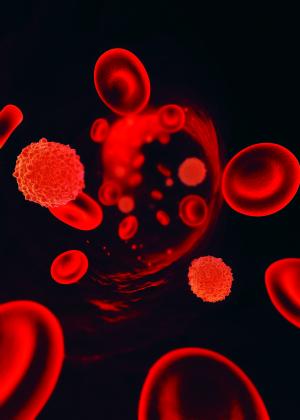Identifying drug targets for leukaemia

The findings could help physicians develop more effective treatment strategies for chronic myelogenous leukaemia. Copyright : Sebastian Kaulitzki
In chronic myelogenous leukaemia (CML), too many stem cells in the bone marrow are transformed into a type of white blood cell called granulocytes, making less room for healthy white blood cells, red blood cells and platelets. CML occurs due to a chromosomal abnormality in which an abnormal gene is formed, called the BCR-ABL fusion gene. However, the development of CML is not fully understood, leading to limited treatment options.
The BCR-ABL gene activates enzyme pathways that disrupt protein synthesis and cause uncontrolled cell growth. A better understanding of these pathways and how they are activated could lead to the discovery of drug targets for CML.
Past research has shown that the expression of a protein-coding gene called NPM1 changes in tumour cells. NPM1 was found to respond to signals from enzyme pathways initiated by the BCR-ABL gene.
Benjamin Yung’s research group at The Hong Kong Polytechnic University together with researchers from Harvard University in the U.S. and Queen Elizabeth Hospital in Hong Kong have developed a unique statistical and mapping strategy that identifies the relationships among those genes that are involved in the development of CML.
Using their unique statistical approach, the researchers quantified and analysed publicly available gene expression data of nine CML patients and eight healthy volunteers. They created networking maps from the data to facilitate the visualization of the connections among genes.
They compared NPM1 gene expressions with those from the BCR-ABL-initiated enzyme pathways in the CML patients and similar pathways that exist in healthy individuals. They also explored the role of NPM1 “doublets” – genes strongly co-expressed with NPM1 – in protein formation.
The researchers identified two sets of gene doublets that strongly co-expressed in CML patients but were not co-expressed in healthy individuals. These gene pairs may be related to CML development and thus could be an important target for drug research.
They also found that NPM1 established ten gene-expressing pairs with BCR-ABL pathways in CML patients but only two pairs with similar pathways in healthy individuals, which may mean that NPM1 mediates the activation of other cellular proliferation pathways in CML.
Finally, the researchers used a substance, called resveratrol, which is thought to have anti-cancer properties, on CML cells. Resveratrol caused a decrease in the expression of NPM1-related proteins and is thus a potential drug target for CML therapy.
The researchers’ findings could help physicians develop more effective treatment strategies for CML. Their statistical and mapping strategy can also be used to diagnose and develop treatments for other diseases.
For further information contact:
Professor Benjamin Yung
Department of Health Technology and Informatics
The Hong Kong Polytechnic University
E-mail: ben.yung@polyu.edu.hk
Associated links
Media Contact
More Information:
http://www.researchsea.comAll latest news from the category: Life Sciences and Chemistry
Articles and reports from the Life Sciences and chemistry area deal with applied and basic research into modern biology, chemistry and human medicine.
Valuable information can be found on a range of life sciences fields including bacteriology, biochemistry, bionics, bioinformatics, biophysics, biotechnology, genetics, geobotany, human biology, marine biology, microbiology, molecular biology, cellular biology, zoology, bioinorganic chemistry, microchemistry and environmental chemistry.
Newest articles

Bringing bio-inspired robots to life
Nebraska researcher Eric Markvicka gets NSF CAREER Award to pursue manufacture of novel materials for soft robotics and stretchable electronics. Engineers are increasingly eager to develop robots that mimic the…

Bella moths use poison to attract mates
Scientists are closer to finding out how. Pyrrolizidine alkaloids are as bitter and toxic as they are hard to pronounce. They’re produced by several different types of plants and are…

AI tool creates ‘synthetic’ images of cells
…for enhanced microscopy analysis. Observing individual cells through microscopes can reveal a range of important cell biological phenomena that frequently play a role in human diseases, but the process of…





















